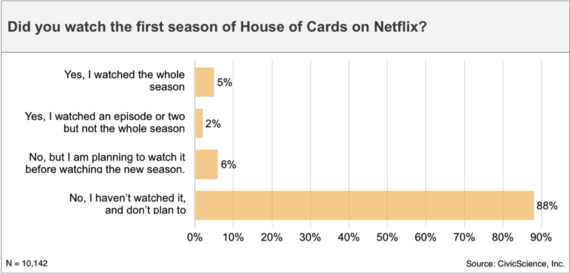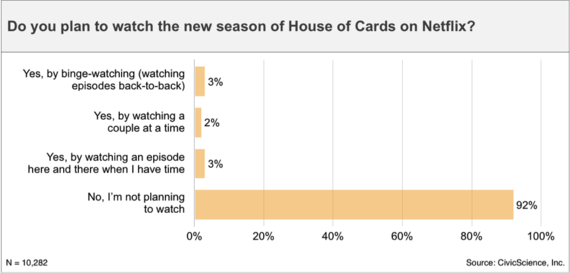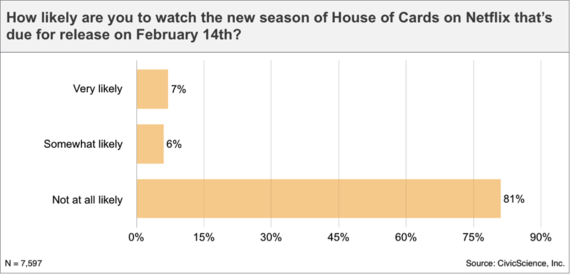There are two groups of people who can't wait for Netflix to release the 2nd season of House of Cards today: People like me who loved the first season and marked our calendars when the release date was announced; And hyper-interested executives in the media and investment sectors who are salivating to see how Netflix's disruptive (sorry, sometimes a buzzword is the only one that describes the situation) foray into original programming progresses.
Netflix's refusal to report on its viewership numbers seems to be driving the media world crazy. It also makes it really hard for a company like ours to forecast the audience size for the show. It took the data scientists at CivicScience two years and twenty-four readings to hone our Economic Sentiment numbers to the prevailing indices. It took us several months and numerous movies before we were able to feel confident about our projections for box office sales. How will we ever test our models for Netflix programming if we don't have real numbers to measure, test, and refine them against?
We could try to build a model by forecasting broadcast or cable television shows and testing them against published ratings. However, ratings only reflect the average audience of a show during a single airing. People who intend to watch House of Cards may watch one episode and quit, watch the whole season in one (albeit long) sitting, or watch episodes sporadically. I watched the first season of House of Cards over a two-week period last August, more than six months after the show was originally released.
We may never know exactly how the show is performing. But we thought CivicScience's polling and analytics platform could shed some light on the projected viewership of House of Cards and how people plan to watch it.
Let's first look at CivicScience's most recent data on who watched season one of the show.
Of the 10,142 U.S. adults we surveyed between February 5th and 8th, 5 percent of respondents claimed to have watched all of season one. A whopping 6 percent claim they still plan to watch it prior to diving into season two. We should take that 6 percent number with a grain of salt -- a lot of people may have every intention of watching but will never get around to it. 93 percent of those season one viewers say that they are likely to watch season two.
There are 226 million adults living in the U.S. 85 percent or 192 million of these adult use the Internet (which is important both because our data is collected online and because you need the Internet to watch Netflix). So, 5 percent of the U.S. adult population who watched the first season would represent about 9.6 million total viewers. That's a hefty number for any show, let alone one behind a subscriber wall like Netflix. 43 percent of those viewers identified themselves as "Married;" we will explain why that's relevant in a moment.
Now let's look at the likely viewers of season two:
Here we surveyed another 10,282 U.S. adults about not only their intent to watch the second season of House of Cards but how they plan to watch. A total of 8 percent of respondents are planning to watch the show with over one-third of those expected to binge-watch most or all of the season at once. If all of these people do in fact tune in, the show could see total viewership jump to 15.3 million. Among this group, 42 percent of respondents identified themselves as "Married" (wait for it).
Looking at this issue one more way, we asked a different question gauging how likely people were to watch the show. Here's what we found:
Here we see that 7 percent of respondents said they are "Very Likely" to watch season two. If we use only those numbers, the show could draw up to 13.4 million total viewers -- at some point in time. This would represent a 3.8 million-viewer or 40 percent jump from season one, notwithstanding the fact that those new viewers will likely go back and watch season one first. Among the "Very Likely" group, we found that 53 percent of respondents identified themselves as "Married."
Why are we so fixated on people's marital status? Here's why.
If you consider that Netflix recently reported having over 31.7 million U.S.-based subscribers, a projected viewership range of between 13.4 million and 15.3 million would seem like a huge percentage of subscriber households. The operative term, however, is "households."
If we use conservative numbers (not even including households with multiple adults who aren't married), let's presume that roughly 42 percent of likely House of Cards viewers live with another adult where only one person has a subscription. For the sake of discussion, let's assume that both adults in those households plan to watch the show. In that case, those 13.4-15.3 million likely viewers would represent between 7.7 and 8.9 million or 24 percent to 28 percent of Netflix subscriber households.
Sadly, we may never know how accurate these numbers truly are. However, even at the low ranges and given the relative increase from our season one to season two numbers, it's safe to say that House of Cards is very popular and growing.



